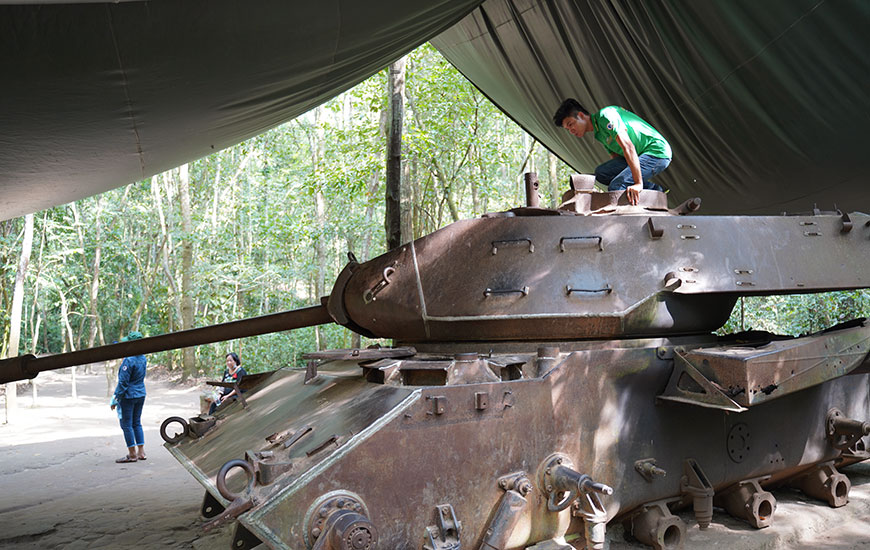Cu Chi Tunnels
The area of Cu Chi is undoubtedly characterised by its perseverance and determination at rebuilding itself after the ravages of the Vietnam War. The area played a pivotal role in the defeat of US troops during the war and is famous for its network of underground tunnels. The labyrinthian network of tunnels was used to conceal the Viet Cong troops and allowed them to send secret communications and stage covert attacks. The tunnels in Cu Chi have become an iconic wartime relic and have are a popular tourist destination for those keen to discover the remarkable measures the Viet Cong soldiers took to survive, and ultimately defeat their enemies. Although the tunnels in Cu Chi have become world famous, the whole system stretches across Vietnam, unravelling underneath the towns and cities, reaching as far as Cambodia in some places.

Descending into the Cu Chi Tunnels.
Although the Cu Chi tunnels are famous for their decisive role in the America-Vietnam war, construction of the tunnels began in the 1940s during the Indochina War. The placement and the complexity of the tunnel's design gave the Viet Cong troops enough of an advantage over the US troops to win the war. Firstly, Cu Chi was occupied by US troops during the war, meaning that the Viet Cong troops could effectively spy on the opposition and gain invaluable information. Secondly, the complex maze of tunnels, chambers, dead ends and booby traps meant that even if an entrance to the tunnels was discovered, it is was extremely difficult fot the intruder to survive in the unknown environment.

Even though the tunnels served as a form of protection, conditions underground were hardly safe. The basics of food, air and water were in limited supply, and hygiene levels were unimaginable. This resulted in the rapid spread of sickness and disease which killed many of the soldiers. On top of this, there was a host of poisonous or deadly animals lurking in the dark, cramped caverns.
Once the US forces realised just how effective the tunnels had become, they launched a number of different campaigns to destroy the ingenious system. Whole areas were bulldozed to the ground, vegetation and rice crops were destroyed by chemical and physical defoliation and carpet bombing began.
Travellers exploring the tiny original entrances to the tunnels.
After the war, the mass destruction and chemical defoliation had completely obliterated the area, and the population was at an all-time low. Since then, the area has been developing with small towns being established and the population growing in numbers.
A classroom or gathering hall within the tunnels.
There are two main sites open to the public in Cu Chi, both offering similar experiences. Ben Duoc is slightly further from Ho Chi Minh, approximately and extra 30 minutes, meaning it is the quieter of the two locations. Ben Dinh is the most popular of the two with the majority or tours choosing to visit this site.
Travellers perusing a historical recreation of a munitions factory within the tunnels.
During the trip, tour guides will explain the detailed layouts of the tunnels and explain their construction. Visitors will get to experience the tunnels first hand as they descend into claustrophobic passageways whilst imagining the plight of the soldiers who were stuck in these tunnels for days and weeks at a time. Displays of the brutal traps the Viet Cong left to maim intruders and a fascinating propaganda video provide further insight into the extremes of war.
Most choose to join a tour to the tunnels from
Ho Chi Minh city or hire a private car. It is also possible to access the area by boat or local bus from Ho Chi Minh.